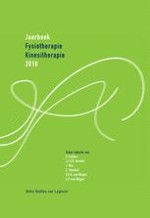Samenvatting
Mensen met multipele sclerose (MS) zijn in het algemeen fysiek minder actief dan de gezonde populatie, als gevolg van de aanwezigheid van symptomen en beperkingen, maar ook van deconditionering en disuse. Intensieve fysieke activiteit ter remediëring hiervan werd tot voor kort afgeraden, maar recente wetenschappelijke literatuur heeft aangetoond dat verschillende soorten oefentherapie veilig kunnen worden toegepast bij MS-patiënten zonder een verhoogd risico op het optreden van een exacerbatie, toename van vermoeidheid of een permanente verergering van symptomen. Oefentherapie leidt, bij ambulante patiënten, vaak tot een verbetering van een aantal functies (spierkracht), activiteiten (wandelen, evenwicht) en levenskwaliteit (participatie, welbevinden).
In dit hoofdstuk wordt voornamelijk de training van de spierkracht en het uithoudingsvermogen toegelicht, die gestandaardiseerd kunnen worden toegepast aan de hand van oefenschema’s. De kinesitherapeut heeft een belangrijke rol bij het opstellen van individuele doelen en een individueel programma, observatie van de functionele status van de persoon, het beoordelen van de haalbaarheid en het herstel na oefentherapie, en overdracht van informatie omtrent MS en inspanning. Zowel praktische oefenschema’s en algemene richtlijnen, de wetenschappelijke evidentie omtrent aangetoonde effecten van oefentherapie als psychosociale aspecten gerelateerd aan oefentherapie, worden besproken.

